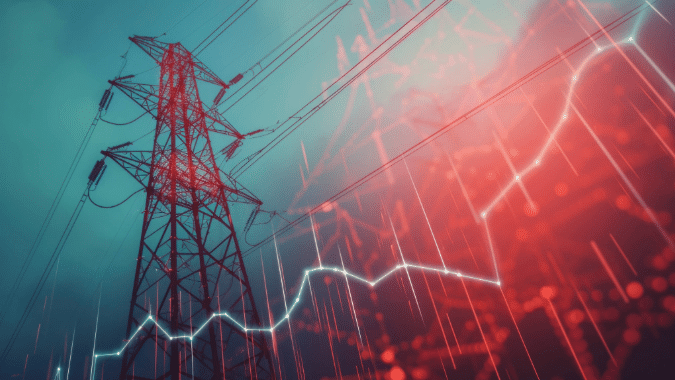The Perfect Storm Leading to the Next Energy Crisis
October 18, 2024

In an eye-opening presentation at NJBIA’s 4th Annual Energy Conference this week, Christie 55 Solutions General Manager Bob Martin gave a concerning picture of how the U.S. is on a fast track for an electric energy crisis – and what can ultimately be done to dodge what he called “the perfect storm.”
“If we don’t address this, we’re going to end up with brownouts, blackouts, we’re going to cut back on energy usage in certain cases and at peak times, and costs (for electricity) are going through the roof,” Martin told the crowd of nearly 300 attendees.
“This will affect businesses and economic growth, as well as residential consumers comfort and electric bills.”
ELECTRIC DEMAND ACCELERATION
Martin, who served as Commissioner of the state Department of Environmental Protection for eight years under Gov. Chris Christie, explained that a convergence of four major competing factors over the next decade are fueling this perfect storm.
In summary, they include:
- Electricity demand in the U.S. will more than double between now and 2050;
- EPA’s recently published final Power Plant Greenhouse Gas (GHG) rules effectively force the closure of all existing base load coal-fired power plants by 2032, and halt any future new investment in efficient low-emitting base load natural gas plants;
- Renewable energy, despite its rapid growth, will not be able to fill the gap created by electricity demand growth and generating plant closures and will be unable to provide baseload and dispatchable electricity to the grid;
- Electric grid modernization, upgrades, and expansion are far from ready to support the renewable energy projected to be added over the next several decades.
“We’re seeing big increases in demand right now with data centers and manufacturing in this country is growing,” Martin said.
“That’s good, but at the same time you’ve got transportation, and EV demands that have increased. You also have increased electrification of homes and businesses, whether those are mandates by states or driven by public policy.”
Data centers brought on by current and projected use of artificial intelligence technologies are a big part of energy consumption upswings, Martin said.
Martin cited a report from the Enterprise Power Research Institute (EPRI) that projects data centers will grow to consume 4.6% to 9.1% of U.S. electricity generation annually by 2030, versus an estimated 4% today.
As it relates to energy for manufacturing, the U.S. Department of Energy has identified more than 200 new manufacturing facilities for batteries, HVAC, EVs and transportation, solar, wind, hydrogen, and nuclear industries have been announced since the Inflation Reduction Act (IRA) was passed in August 2022.
STRANGLEHOLD ON SUPPLY
Martin said powerplant closures in the U.S. will be accelerated by EPA’s Power Plant Greenhouse Gas Rules and other state laws.
“We expected those to close down, but now we’re starting to see that they’re being accelerated or will be accelerated (by the EPA rules),” Martin said.
“The rules are going force closures at a faster pace, but probably more importantly, they’re going to discourage investment in new power plants in this country – and especially natural gas efficient plants at the same time where we need more power.”
Any existing coal-fired units that are scheduled to operate after Jan. 1, 2039, will be required to have Carbon Capture and Sequestration (CCS) technology; and the same goes for new baseload natural gas turbines after Jan. 1, 2031.
“Targeting new natural gas plants will likely discourage capital investments in future plants, which compounds the problem,” Martin said.
GRID IS NOT GREAT
Martin summarized that the U.S. electric grid is not prepared for significant load growth and, more importantly, has not kept up with the increase of solar and wind power.
And facing the biggest load growth challenge is the PJM grid, which New Jersey and 12 other states are a part of.
In board slides as part of his presentation, Martin said electric demand for PJM is projected to increase 68% by 2050, compared to 57% in all other grid regions in the nation.
“I would argue those numbers are still on the low end at the end of the day, so we’ve got our challenges in front of us,” he said.
Complicating matters, Martin pointed out, is the PJM footprint is home to Data Center Alley in Loudoun County, Virginia, the largest concentration of data centers in the world.
A presentation slide added that PJM’s Load Forecast could exhibit demand growth as high as 7% annually due to the expansion of data centers and overall electrification.
For example, in 2022, the Load Analysis Subcommittee (LAS) began a review of data center load growth and “identified growth rates over 300% in some instances.”
In addition, “PJM is expecting an increase in electrification resulting from state and federal policies and regulations.” That growth is illustrated in PJM’s Load Forecast which demonstrates that, “due to the expansion of data centers, combined with overall electrification, certain individual zones exhibit more significant demand growth — as high as 7% annually.”
STAVING OFF THE STORM
Martin identified “good news” in that renewables will be a critical part of the U.S. energy portfolio.
The U.S. Energy Information Administration projects that wind and solar energy will account for 44% of the electricity generated by 2050.
“This has strong support,” Martin said. “But you can’t necessarily look at it as a 1-for-1 replacement. You can’t replace 1 megawatt of baseload, combined cycle plant energy with 1 megawatt of renewable energy. And that’s OK. But we’ve got to make sure we plan (for more renewable energy sources), permit it and build it.”
Martin also said nuclear power must be a major part of the U.S. energy portfolio in order for a smoother overall transition to electrical power.
Martin listed other ways to avert, or at least lessen, the projected electric crisis. Broadly, they included:
- Public policy changes
- Better planning at the national, regional and state levels
- Investment in high-efficiency natural gas power plants to bridge the gap of an extended electric transition
- Reevaluate EPA regulations that force the closure of existing power plants and discourage the investment in new gas units
- Require significant investment in the transmission grid
- Continue the push for renewable power for long-term energy security
Martin also said there will also need to be significant private investment to help avoid an electric energy crisis.
“The private sector needs to play a role in investing in this overall energy plan and addressing all these issues,” he said. “Just relying on Washington is not the answer at the end of the day.”
Search
RECENT PRESS RELEASES
Related Post




